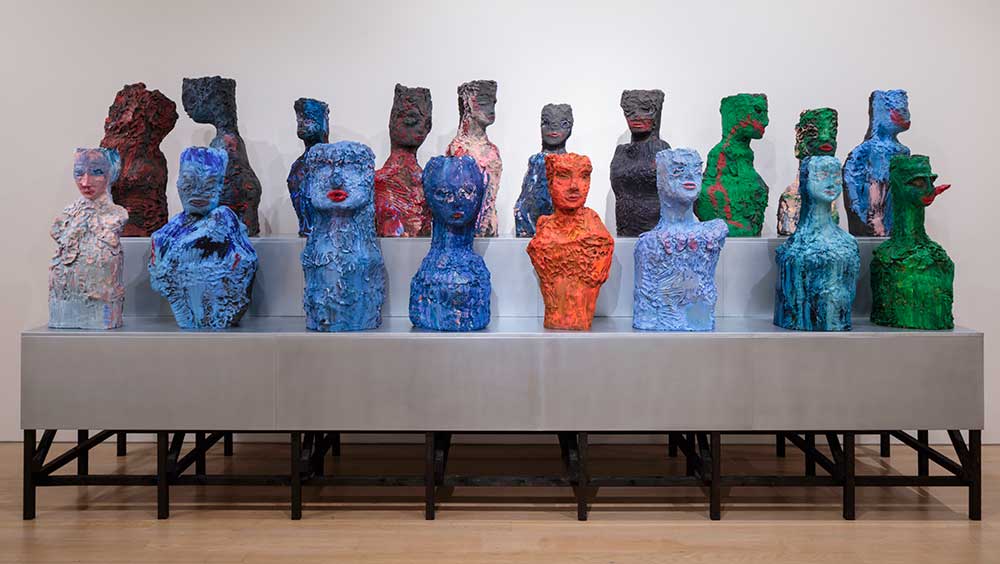
Daniel Silver. The Audience, 2022. Oil painted ceramic. Installation view the Fruitmarket. Courtesy the artist and Frith Street Gallery, London. Photo: Ruth Clark.
Fruitmarket, Edinburgh
11 June – 25 September 2022
Edinburgh Festivals Exhibition
by BETH WILLIAMSON
We are all accustomed to looking in an exhibition, but have you ever had that look returned to you? Have you been made to feel you are exchanging glances with the artwork, being drawn into a group of figures, perhaps, or even had your gaze refused or deflected so you feel uncomfortable, an intruder of sorts? Be prepared for all these experiences in this, the first exhibition in Scotland by the London-based artist Daniel Silver. Silver’s works speak of connection and disconnection, of inclusion and exclusion, of touching and refusing touch. Fundamentally, this exhibition is about human connection without words.
Central to the exhibition is a group of busts, The Audience (2022), arranged in two tiers. Silver explains that those in the first tier were made at the same time in a group, or what he calls a family, and those in the second tier were made together as another family. They can, he says, exist individually but they are much happier together.
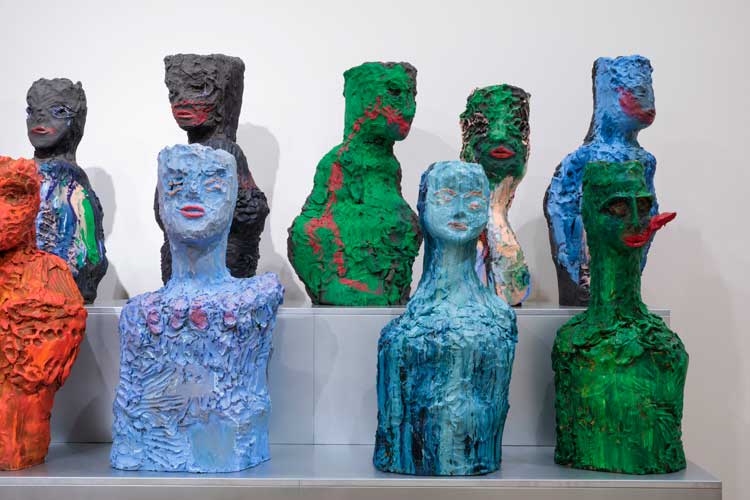
Daniel Silver. The Audience, 2022. Oil painted ceramic. Installation view the Fruitmarket. Courtesy the artist and Frith Street Gallery, London. Photo: Ruth Clark.
Fiona Bradley, the Fruitmarket’s director, likens The Audience to a jury, or an audience in a theatre or sports stadium, although my sense of the group was more one of a Greek chorus, a guiding voice for the audience or viewer, full of dithyrambic song as some tragedy or other unfolds. Of course, that can’t be quite right as a Greek chorus would be all male, but Silver says he never knows if his figures are male or female – it doesn’t matter. At times, the clay surface remains black, just as it came out of the kiln – the artist uses smooth black clay with a metal dust component, so it turns jet black when fired. Often a figure has a skin of paint applied. All these figures show the marks of their making, the intimacy of the artist’s touch and the process of making alone in the studio. In a recent conversation with the curator, Mark Godfrey, Silver observed: “People have presence, and I found that their presence was affecting me as a maker, and I wanted to try and figure out my own mark.” Silver asked his studio assistants to leave. He is clear that, in making alone, he achieves a greater freedom and intensity and that is evident in the finished pieces as the clay retains the fingermarks, smears and imprint of Silver’s making.
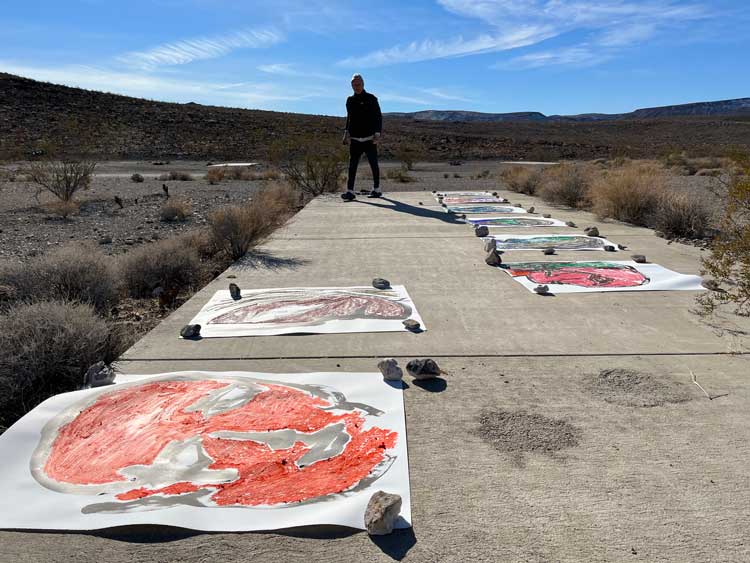
Daniel Silver painting in Death Valley, California, 2021.
Around the lower gallery space, the walls are lined with a series of works on paper, heads painted quickly in gestures so swift that it seems almost miraculous that their trace is captured at all. Nicely spaced out, they surround The Audience but keep their distance and do not crowd. These works were made in Death Valley, California, flat on concrete slabs in the crushing heat. I think I see a Japanese kabuki mask, a Mexican god and a Man of Sorrows among them, but Silver talks about these two-dimensional works in a more conceptual manner. He mentions an Eva Hesse work – he is referring to Hang Up (1966), I think – to explain how these images enable a way in to the picture space and a way out again, providing a more three-dimensional understanding for these works on paper. These highly gestural works (Silver acknowledges American abstract expressionism as a touchstone here) are so close in their conception to The Audience that we might think of them as an extension of the same thing.
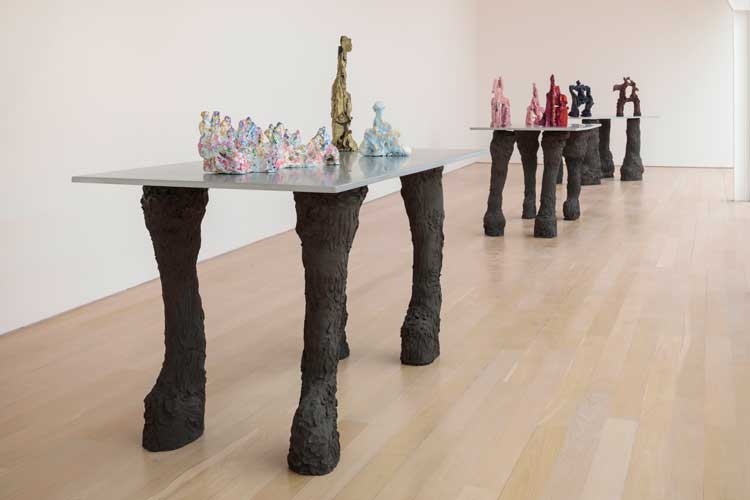
Daniel Silver. Looking. Installation view, Fruitmarket, 2022. Courtesy the artist and Frith Street Gallery, London. Photo: Ruth Clark.
In a small side room, two tall floor-standing statues face each other as if in intimate and private conversation. Silver points out the Guston pink he has used on one figure, and I ask about its lower limbs, reminiscent of those often used by Simone Fattal in her sculpture. Silver smiles and acknowledges his interest in Fattal’s work, although he has never met her. Heart, Orange and Lover (pink), both 2020, are so utterly complete in their pairing that I know I am intruding – I don’t stay long.
.jpg)
Daniel Silver. Love (pink), 2020. Oil painted ceramic, 186 x 80 x 34 cm. Courtesy the artist and Frith Street Gallery, London.
In the Fruitmarket’s new Warehouse space, Silver’s dark totemic works are incredibly powerful and strong. As if the walk along the corridor to the Warehouse is not anticipatory enough, the quiet Fattalesque presence of these works resonates among the pillars and the shadows. The dramatically lit space is used to its best advantage and the emphatic materiality of these works does not diminish their votive nature. There are just a handful of large works, not figurative but anthropomorphic, spaced out in the darkness of the Warehouse, that invite slow contemplative looking and walking, and it is difficult to leave them behind.
In the light upper exhibition gallery with its central stairwell, Silver has constructed a series of waist-height tables, each with a group of small painted clay figures or heads. These sociable little groupings were all made while Silver hosted a dancer in the studio alongside him. He explains the unconscious exchange between the dancer and himself, and his understanding of how a dancer inhabits their body, in the same way as an artist inhabits their hands. The small figures are mute, but I felt my experiencing of looking and moving around between them immeasurably enriched by the babble of conversation that drifted up from the cafe downstairs. While the dimly lit Warehouse was a quiet space inviting gradual movement and reflection, this airy upper gallery with its conversational backdrop and convivial groupings is entirely the opposite, pulsating with energy and movement.
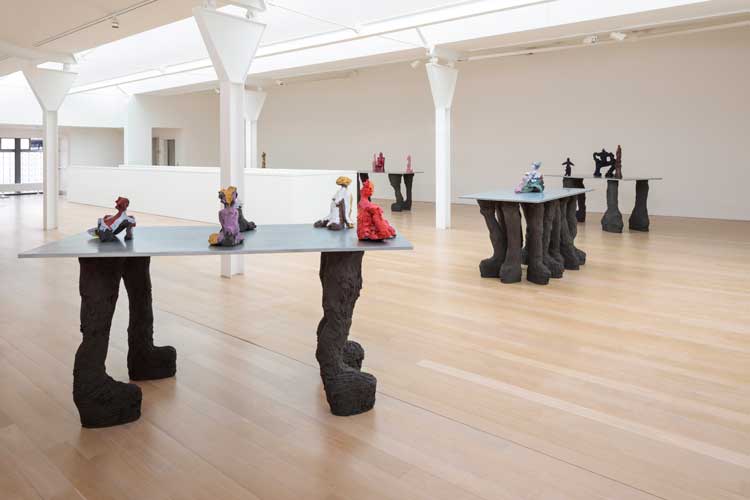
Daniel Silver. Looking. Installation view, Fruitmarket, 2022. Courtesy the artist and Frith Street Gallery, London. Photo: Ruth Clark.
As I cross the floor between the different groups, it occurs to me that Silver’s Jewish heritage and an associated history of Jewish migration and movement, leaving one place and arriving in another, is another aspect of his work that resonated perfectly at the Fruitmarket, next door to Edinburgh Waverley train station, a gateway to the north and the south. In this space of flux, Silver’s small sculptures seem restless, filled with an eagerness and vitality that his larger sculptures positively refuse. Set out on Silver’s custom-made tables across the entire upper floor, these small figures embody moments of joy, abandon, love, excitement. Movement and emotion captured in small sculptures. This is such a shift in atmosphere and emotional pull from the sculptural groupings shown downstairs. It may still be about looking and being looked at and a tricky balance between figuration, abstraction and anthropomorphism. In the end, however, it is the complexity of approaches to scale, conception, dimension and movement that make this exhibition so strong.
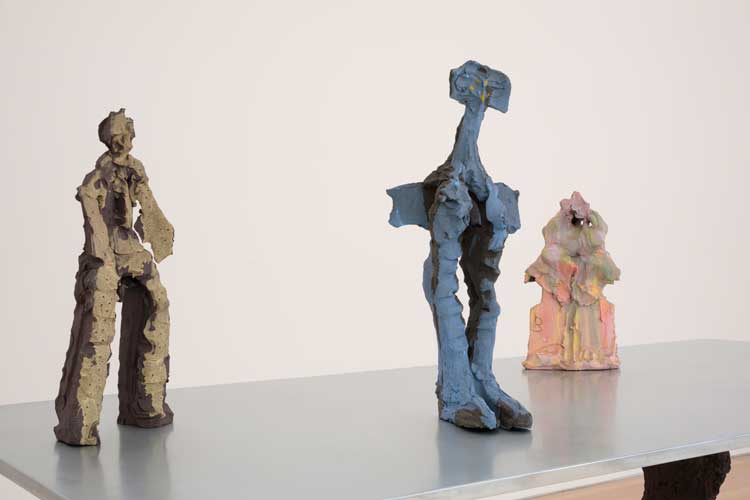
Daniel Silver. Untitled, 2022. Oil on ceramic sculptures on zinc table with ceramic legs. Courtesy the artist and Frith Street Gallery, London. Photo: Ruth Clark.